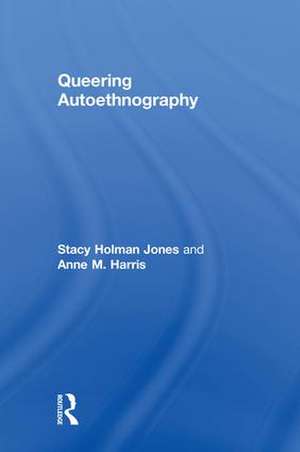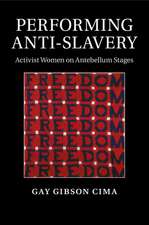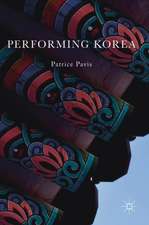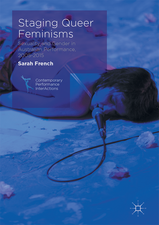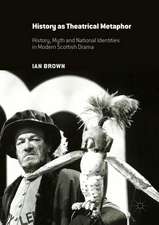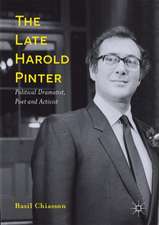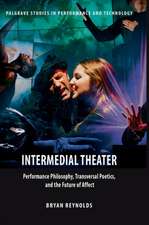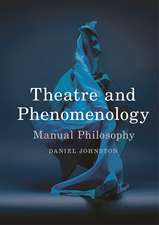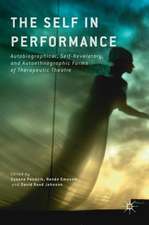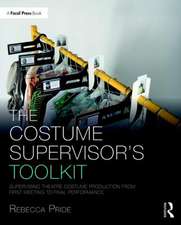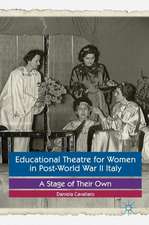Queering Autoethnography
Autor Stacy Holman Jones, Anne M. Harrisen Limba Engleză Hardback – 14 aug 2018
This volume considers flash points in contemporary scholarly and popular culture such as queer memorializing and mourning; unintelligibility and monstrosity; physical, digital and cultural transformations of queer lives and bodies; the power and danger wrought in the public assembly of queer people in a culture of massacre; and the promise of queer futurities in the contemporary moment. It also makes original theoretical contributions that include concepts such as massacre culture, queer terror, mundane annihilations, and activist affect. The authors write these ideas in action, joining theory and story as a contact zone for analysis, critique and change.
| Toate formatele și edițiile | Preț | Express |
|---|---|---|
| Paperback (1) | 359.76 lei 43-57 zile | |
| Taylor & Francis – 15 aug 2018 | 359.76 lei 43-57 zile | |
| Hardback (1) | 1000.27 lei 43-57 zile | |
| Taylor & Francis – 14 aug 2018 | 1000.27 lei 43-57 zile |
Preț: 1000.27 lei
Preț vechi: 1219.84 lei
-18% Nou
Puncte Express: 1500
Preț estimativ în valută:
191.40€ • 200.37$ • 158.37£
191.40€ • 200.37$ • 158.37£
Carte tipărită la comandă
Livrare economică 07-21 aprilie
Preluare comenzi: 021 569.72.76
Specificații
ISBN-13: 9781138286153
ISBN-10: 113828615X
Pagini: 140
Dimensiuni: 152 x 229 x 10 mm
Greutate: 0.45 kg
Ediția:1
Editura: Taylor & Francis
Colecția Routledge
Locul publicării:Oxford, United Kingdom
ISBN-10: 113828615X
Pagini: 140
Dimensiuni: 152 x 229 x 10 mm
Greutate: 0.45 kg
Ediția:1
Editura: Taylor & Francis
Colecția Routledge
Locul publicării:Oxford, United Kingdom
Cuprins
Acknowledgments
Introduction
Chapter 1: Queering Monuments
Chapter 2: Queering Massacres
Chapter 3: Queering Movements
Chapter 4: Queering Mx
Chapter 5: Queering Monsters
Chapter 6: Queering Memory
Introduction
Chapter 1: Queering Monuments
Chapter 2: Queering Massacres
Chapter 3: Queering Movements
Chapter 4: Queering Mx
Chapter 5: Queering Monsters
Chapter 6: Queering Memory
Notă biografică
Stacy Holman Jones is Professor in the Centre for Theatre and Performance at Monash University
Anne M. Harris is Vice Chancellor’s Principal Research Fellow and Associate Professor at RMIT University
Anne M. Harris is Vice Chancellor’s Principal Research Fellow and Associate Professor at RMIT University
Recenzii
A stunning accomplishment, moving the discourse on autoethnography, politics, practice and the performing body to new levels. Defines the field for the next generation.
Norman K. Denzin, Emeritus Professor of Sociology, University of Illinois
To be, or not to be, queer. That is not the question. It is not a dilemma. It is a positionality of being and seeing and knowing oneself and others in the world. To queer is a critical act of politicized being, of seeing and calling others to attend to the realities of the everyday; and especially to recover the disregarded/discarded/disremembered other.
In their new book, Queering Autoethnography, Stacy Holman Jones and Anne Harris chart a positionality in research on contemporary global cultures; not a stance but a politicized and practiced path for exploring the complexity of queering autoethnography as a point of entry and departure, as self-reflection, self-portraiture, self-renewing; and establishing an ocular epistemology as method of queering monuments, massacres, movements, Mx, monsters, and memory through the critical articulation of lived experience. The alliteration of their intense focus is not merely literary device, though this work signals and embodies the criticality of performative writing. The technique signals a repetition of consonance and its opposite in everyday life to which queering becomes a tool of mining or excavating ways of seeing and knowing. Thus, offering strategies of engagement to remake the world, anew. This important work exemplifies the reflexive turn in performance and sociological research by focusing not only on queering and autoethnography as separate critical methodologies but turns the critical focus of each, on and at the service of the other. Hence, not only instantiating an act of queering autoethnography, but autoethnographically queering as an embodied praxis. Queering Autoethnography is a must read for those exploring the interdisciplinary complexities of critical sense-making through queering and autoethnography, and what happens when the two co-inform ways of seeing contemporary global cultures from the mundane to the spectacular.
Bryant Keith Alexander, PhD, Professor of Communication and Performance Studies, and Dean, College of Communication and Fine Arts, Loyola Marymount University
Queering Autoethnography is a risky, inspired, and transformative book that adds new and critically important dimensions to autoethnographic inquiry by showing us how to deploy queering practices that can mobilize change and transform the future. Writing the hyphen between the invisible and the recognizable, exclusion and inclusion, outside and inside, Holman Jones and Harris navigate the complicated emotional landscape of lives and lived experiences that so often remain unintelligible to and unvalued by family, colleagues, and acquaintances living comfortably within the dominion of heteronormative desires. Weaving deeply personal with incisively academic narration, they produce a text that interrupts, disrupts, and unsettles, offering acts of resistance to living in a constant state of fear, while imagining a more promising, even playful, future devoid of the terrifying racism, xenophobia, ageism, and sexism in which so many of us are immersed today. Absorbing and empowering, Queering Autoethnography is a soulful, empowering, and socially important book that reveals autoethnography’s evocative power in teaching us how to continue to learn from the stories we find within ourselves and our lived experiences.
Arthur P. Bochner, Distinguished University Professor of Communication, University of South Florida
Norman K. Denzin, Emeritus Professor of Sociology, University of Illinois
To be, or not to be, queer. That is not the question. It is not a dilemma. It is a positionality of being and seeing and knowing oneself and others in the world. To queer is a critical act of politicized being, of seeing and calling others to attend to the realities of the everyday; and especially to recover the disregarded/discarded/disremembered other.
In their new book, Queering Autoethnography, Stacy Holman Jones and Anne Harris chart a positionality in research on contemporary global cultures; not a stance but a politicized and practiced path for exploring the complexity of queering autoethnography as a point of entry and departure, as self-reflection, self-portraiture, self-renewing; and establishing an ocular epistemology as method of queering monuments, massacres, movements, Mx, monsters, and memory through the critical articulation of lived experience. The alliteration of their intense focus is not merely literary device, though this work signals and embodies the criticality of performative writing. The technique signals a repetition of consonance and its opposite in everyday life to which queering becomes a tool of mining or excavating ways of seeing and knowing. Thus, offering strategies of engagement to remake the world, anew. This important work exemplifies the reflexive turn in performance and sociological research by focusing not only on queering and autoethnography as separate critical methodologies but turns the critical focus of each, on and at the service of the other. Hence, not only instantiating an act of queering autoethnography, but autoethnographically queering as an embodied praxis. Queering Autoethnography is a must read for those exploring the interdisciplinary complexities of critical sense-making through queering and autoethnography, and what happens when the two co-inform ways of seeing contemporary global cultures from the mundane to the spectacular.
Bryant Keith Alexander, PhD, Professor of Communication and Performance Studies, and Dean, College of Communication and Fine Arts, Loyola Marymount University
Queering Autoethnography is a risky, inspired, and transformative book that adds new and critically important dimensions to autoethnographic inquiry by showing us how to deploy queering practices that can mobilize change and transform the future. Writing the hyphen between the invisible and the recognizable, exclusion and inclusion, outside and inside, Holman Jones and Harris navigate the complicated emotional landscape of lives and lived experiences that so often remain unintelligible to and unvalued by family, colleagues, and acquaintances living comfortably within the dominion of heteronormative desires. Weaving deeply personal with incisively academic narration, they produce a text that interrupts, disrupts, and unsettles, offering acts of resistance to living in a constant state of fear, while imagining a more promising, even playful, future devoid of the terrifying racism, xenophobia, ageism, and sexism in which so many of us are immersed today. Absorbing and empowering, Queering Autoethnography is a soulful, empowering, and socially important book that reveals autoethnography’s evocative power in teaching us how to continue to learn from the stories we find within ourselves and our lived experiences.
Arthur P. Bochner, Distinguished University Professor of Communication, University of South Florida
Descriere
Queering Autoethnography explores the challenging terrain of non-assimilationist narratives of gender and sexuality and of qualitative methods including autoethnography.
